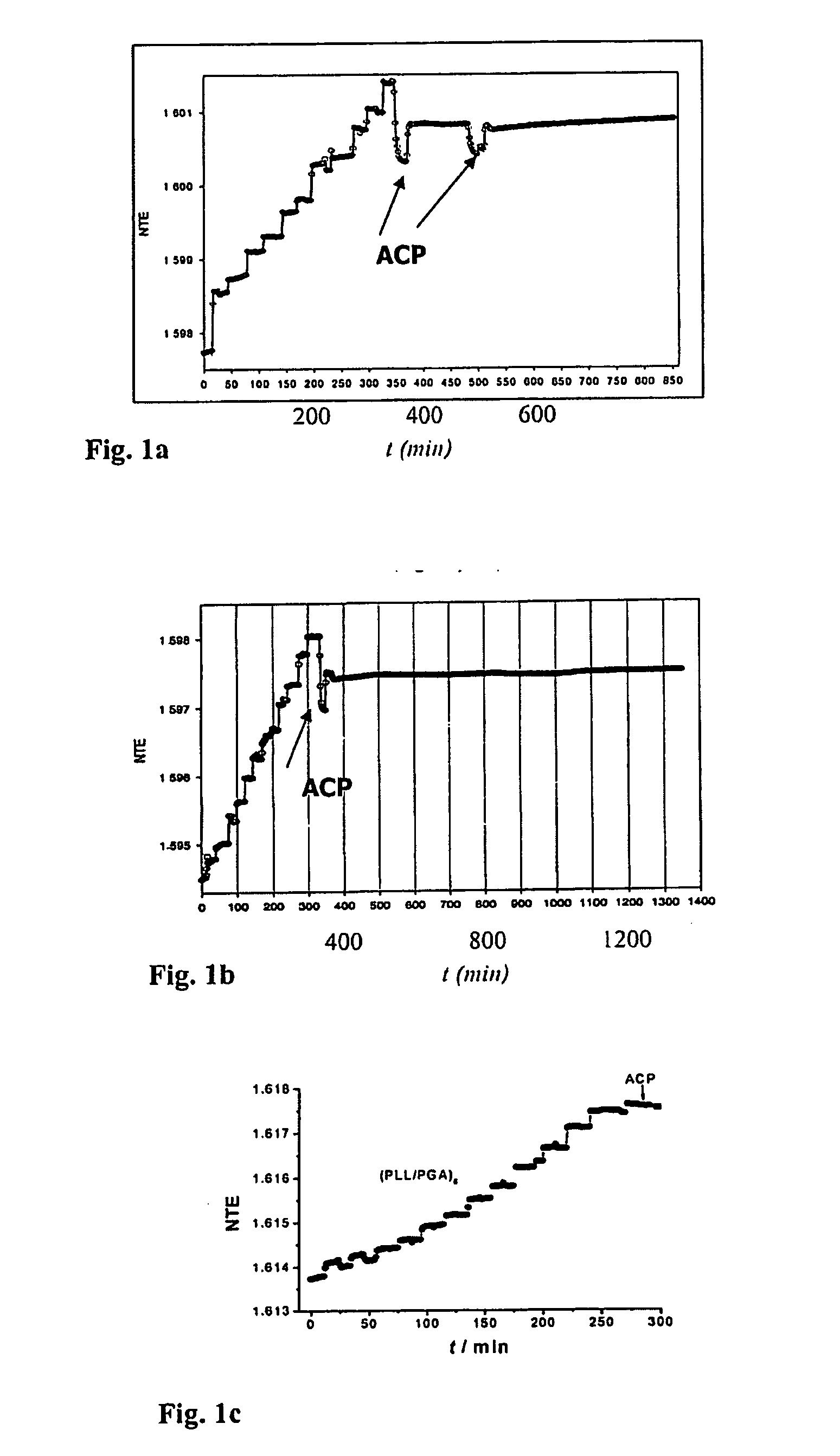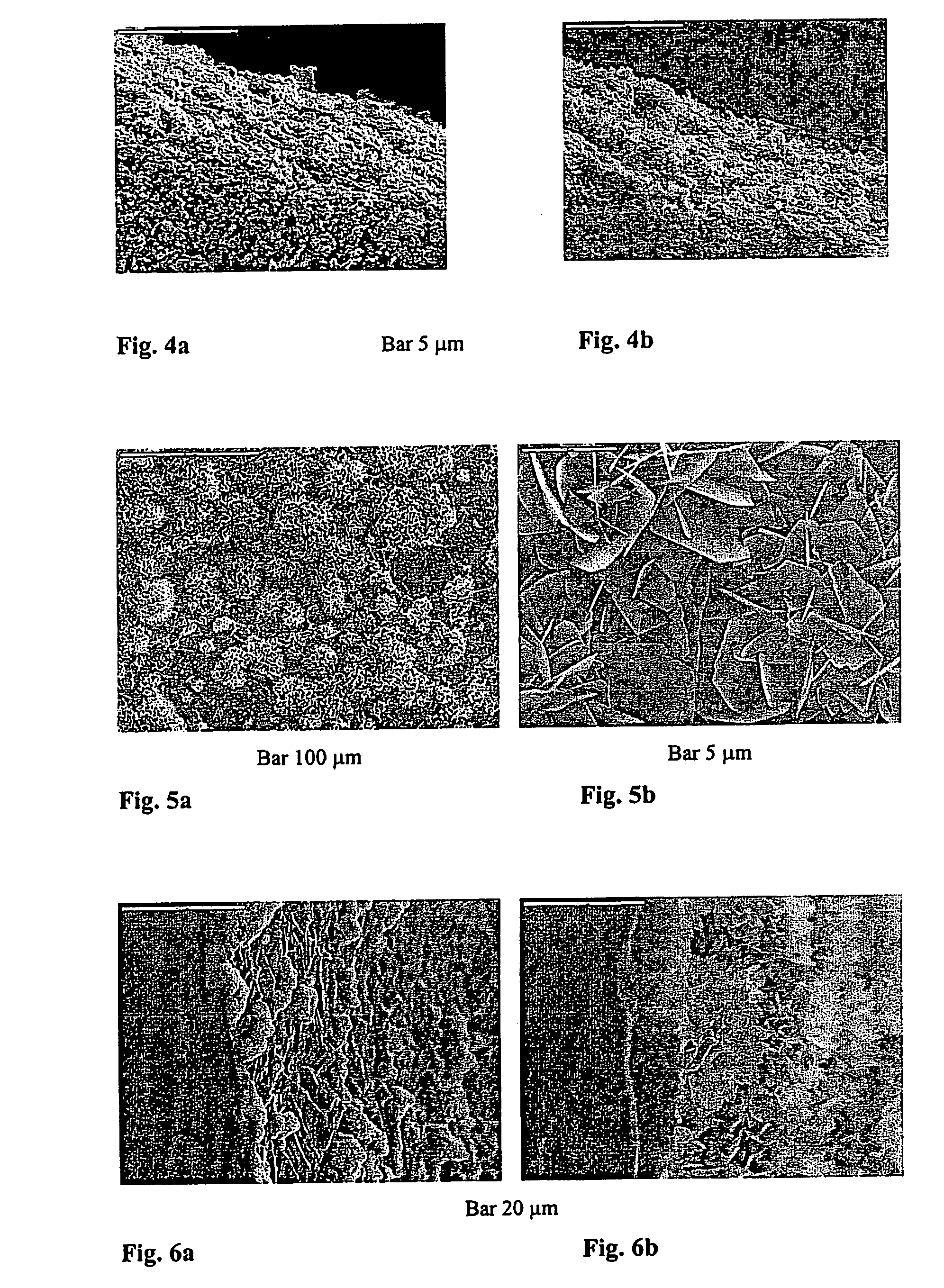Organic-inorganic nanocomposite coatings for implant materials and methods of preparation thereof
a technology of nanocomposite coatings and implants, which is applied in the field of organicinorganic nanocomposite coatings for implant materials, can solve the problems of poor or non-existent interfacial bonding between the metallic surface and the surrounding bone, requiring expensive equipment and high processing temperatures, and mechanical failure at the interface metal-coating interface and within the coating itsel
- Summary
- Abstract
- Description
- Claims
- Application Information
AI Technical Summary
Benefits of technology
Problems solved by technology
Method used
Image
Examples
example 1
Buildup of SAPF and Adsorption of Amorphous Calcium Phosphate on Glass Plates.
[0045] Materials and methods: Poly(L-lysine) (PLL, MW 3.26×104 Da), poly(L-glutamic acid) (PGA, MW 7.2×104 Da), tris(hydroxymethyl) aminomethane (TRIS), 2-(N-morpholino) ethanesulfonic acid (MES), N-2-Hydroxyethylpiperazine-N′-2-ethanesulfonic acid (HEPES), and NaCl from Sigma, and ultrapure water, UPW (Milli Q-plus system, Millipore or Barnstead) were used. MES / TRIS / NaCl or HEPES buffer solutions of pH 7.4 were prepared as follows: MES / TRIS / NaCl buffer: 25 mmol of MES, 25 mmol of TRIS and 100 mmol of NaCl were dissolved in 1 liter of UPW. HEPES / NaCl buffer: 25 mmol of HEPES and 150 mmol NaCl were dissolved in 1 l of UPW. Polyelectrolyte solutions were always freshly prepared by direct dissolution of the respective adequate weights in filtered buffer solutions. Suspensions of ACP were freshly prepared for each experiment by rapidly mixing equal volumes of 3, 5 or 10 mmolar equimolar solutions of calcium ...
example 2
Build-Up of SAPF on Ti Plates and Deposition of ACP Particles Upon Them.
[0050] Materials and Methods: Pure titanium plates, were received courtesy of Dentaurum, J. P. Winkelstroeter AG, Germany (Titanium ASTM grade 4, diameter 15 mm, thickness 1.5 mm, machine polished to a surface roughness Ra 0.4 μm, Rmax 3.0 μm and cleaned in perchloroethylene) and courtesy of SAMO S.p.A., Italy (Titanium ASTM grade 2, 1×1 cm, thickness 1.5 mm, chemically etched by SAMO). Before coating, plates were sonicated subsequently in acetone (p.a.), ethanol (p.a.) and three times in UPW. Each procedure lasted 10-15 min. XRD spectra of the bare plates showed only peaks characteristic of Ti.
[0051] Material A: (PLL / PGA)i and (PLL / PGA)iPLL (i=9 or 14) multilayers were deposited as described in Example 1, using 1 ml of the respective solutions of PLL, PGA and HEPES / NaCl buffer pH 7.4. The plates with adsorbed multilayers were washed with buffer before depositing ACP particles. Plates were dipped three times ...
example 3
Coatings C and D Obtained by Build-Up of SAPF+ACP on Ti Plates and In-Situ Growth of OCP Crystals.
[0055] Coatings C and D: Materials A and B, respectively, were prepared on Ti plates as described in Example 2. Thus prepared plates were immersed into a calcifying solution (2.8 mmol / 1 CaCl2, 2 mmol / 1 Na2HPO4, 25 mmol / 1 HEPES, 150 mmol / 1 NaCl, pH 7.4) for 48 hours. By this procedure material A converted into coating C, whereas material B gave coating D. After the crystallizing procedure all plates were washed with buffer, dried in a stream of nitrogen and kept at 4° C. until further analysis by X-ray powder diffraction and SEM. The adhesive tape test was conducted according to ASTM D 3359-92a and the tested specimens were observed with SEM.
[0056] Reference is made now to FIG. 5 showing SEM micrographs of coating C. Large, well developed, plate-like crystals, oriented perpendicular to the substrate were obtained. Apparently, the crystals grew from the previously deposited aggregated ...
PUM
| Property | Measurement | Unit |
|---|---|---|
| temperature | aaaaa | aaaaa |
| MW | aaaaa | aaaaa |
| pH | aaaaa | aaaaa |
Abstract
Description
Claims
Application Information
 Login to View More
Login to View More - R&D
- Intellectual Property
- Life Sciences
- Materials
- Tech Scout
- Unparalleled Data Quality
- Higher Quality Content
- 60% Fewer Hallucinations
Browse by: Latest US Patents, China's latest patents, Technical Efficacy Thesaurus, Application Domain, Technology Topic, Popular Technical Reports.
© 2025 PatSnap. All rights reserved.Legal|Privacy policy|Modern Slavery Act Transparency Statement|Sitemap|About US| Contact US: help@patsnap.com



